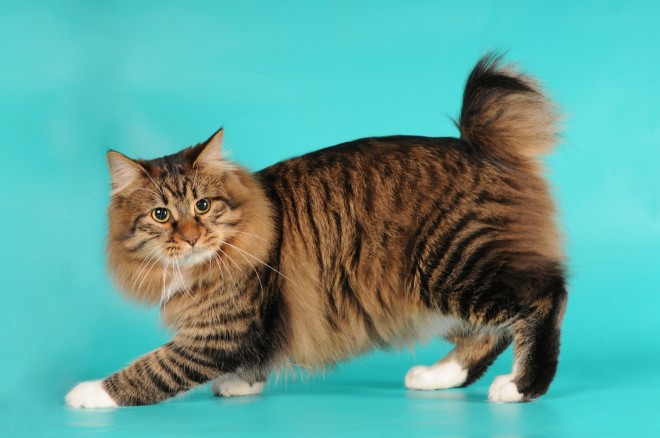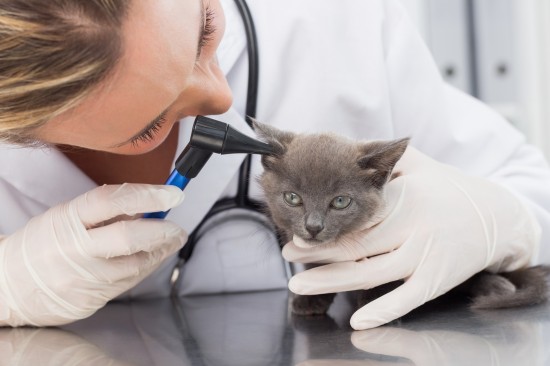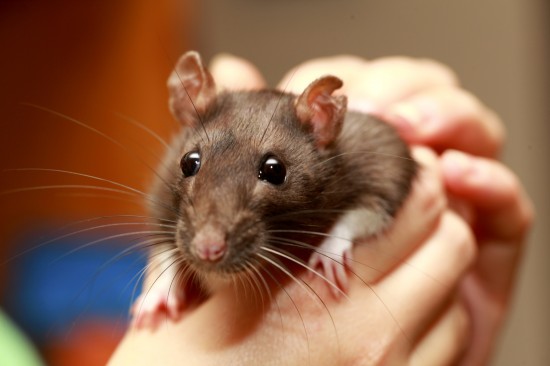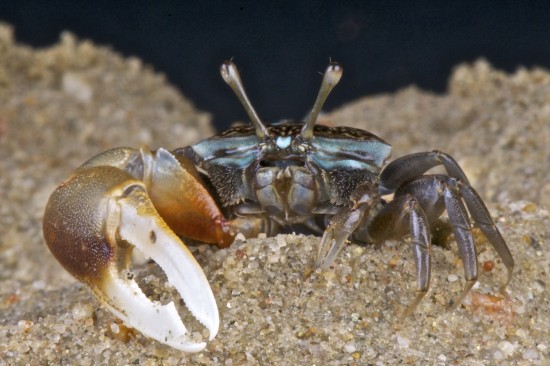
What Causes Cushing’s Disease?
The pituitary gland, located within the brain, acts like the
master gland of the body. It makes hormones that control other
glands, two of which are the adrenal glands, paired glands
located next to the kidneys. These glands make glucocorticoids
which, when produced in excess, cause the signs of Cushing’s. It
is the equivalent of the body making its own source of steroids,
such as prednisone, in excessive amounts.
Signs of Cushing’s
These usually include thinning of the hair and skin changes;
pot-bellied appearance; increased water consumption; increased
urination; increased food intake; panting; weakness and fatigue.
Pets may show some or all of these signs. If this condition is
not treated, diabetes, hypertension, clot formation (embolism)
and infections can result. Dogs are usually affected, but
occasionally, cats, especially diabetic cats, can have this as a
concurrent illness.
The Pituitary Gland & Cushing’s Disease
This is the most common form of Cushing’s. It is associated with
a usually benign tumor that secretes a hormone that causes the
adrenals to stay “on” all the time. This form of Cushing’s is
responsive to medical treatment. Occasionally, these tumors can
get large enough to increase pressure in the brain and cause
neurological signs (personality changes, seizures, circling).
The Adrenal Gland & Cushing’s Disease
This is the less common form of Cushing’s. It is associated with
a benign or malignant tumor of the adrenal gland. This form is
less responsive to medical treatment and often requires surgery
to treat.
Diagnosis of Cushing’s
Initially, some indications of this disease can be noted on a
complete blood panel. But more specific tests to diagnose
Cushing’s include an ACTH stimulation test and/or a low dose
dexamethasone suppression test. These tests usually indicate if
the dog has Cushing’s or not. Other tests must be done such as a
high dose dexamethasone suppression test, measurement of
endogenous ACTH or an abdominal ultrasound to differentiate
between pituitary and adrenal based tumor. This is important to
do since these conditions are treated differently.
Treatment
For the pituitary gland tumor, treatment is done with either
lysodren, ketoconazole, anipryl, or trilostane. For the adrenal
gland tumor, treatment can be medical with lysodren or
ketoconazole or surgery. Your veterinarian will discuss the
benefits and drawbacks of each form of treatment to decide what
is best for your pet.
Lysodren (Op,DDD, Mitotane)
This is a drug that selectively kills the adrenal gland cells so
that less steroids are produced. This is given at a higher dose
initially (the induction period) twice daily, and then at a
lower dose 1-3 times a week for maintenance and control of the
disease on an ongoing basis. Especially when given at higher
doses, this drug has potential side-effects among which are
vomiting, diarrhea and loss of appetite. Occasionally, if this
drug works too well, too much of the adrenal glands are killed,
resulting in a loss of ability to make steroids. However, this
condition, called Addison’s or hypoadrenocorticism, is medically
manageable. Lysodren tends to be expensive, especially in the
initial period since more of it is being given; it is less
costly at maintenance levels when lower amounts are being given.
Side-effects can occur with use of this drug so that your
veterinarian will want to closely monitor your pet, especially
during the induction period. Such side effects should be
reported immediately as these may indicate a need to reduce the
dosage of the medication or stop it altogether. It is important
with this drug that enough is given to control the disease but
not too much is given to avoid making the animal ill.
An ACTH stimulation test helps to monitor the animal’s response
to the lysodren and should be done at the end of the induction
period, then again about a month after starting onto the
maintenance therapy and then every 4-6 months thereafter. With
lysodren for most dogs, this maintenance regime with lysodren
will control the disease; however, there may be relapses and
then the induction phase must be repeated. In addition to doing
the ACTH stimulation tests to monitor response to lysodren, your
veterinarian will also want to do general blood tests and urine
cultures on a regular basis, about every 6 months. Treatment and
monitoring are life-long.
Ketaconazole (Nizoral)
This drug interferes with the body’s steroid production, and it
must be given twice a day on an ongoing basis. Side-effects of
this drug include lethargy, vomiting, decreased appetite and
occasionally, liver disease. Your veterinarian will want to
monitor your pet’s response with blood and urine tests done on a
regular basis. Treatment and monitoring are life long.
L-deprenyl (Anipryl/Selegiline)
This drug helps to normalize dopamine levels and indirectly
controls pituitary function. This drug also has antioxidant and
neuroprotective properties and is often used in the treatment of
canine cognitive dysfunction (“senility”). This medication is
given once daily in the morning on an ongoing basis. A low dose
is initiated, and depending on the animal’s response, the dose
may be increased. Side-effects are rare but can include
vomiting, diarrhea, decreased energy and restlessness.
While there are no specific changes in the blood or urine that
occur with the treatment of anipryl, your veterinarian will want
to monitor your pet with blood and urine tests on a regular
basis for infections and other problems that might arise during
treatment. Treatment and monitoring are long-term with general
blood and urine tests done on a regular basis although specific
tests to monitor the animal’s hormone status such as ACTH
stimulation test are not needed.
Trilostane (Modrenal/Vetoryl)
This relatively new drug interferes with steroid production and
works well in an estimated 80% of dogs with pituitary based
disease. It is given once or twice daily on an ongoing basis,
and improvement with water intake and urine output is usually
noticed within a few weeks. Improvement with coat, skin
condition and muscle tone occurs later. Side-effects are few but
include decreased appetite and lethargy, and reducing the dose
or stopping the drug allows for quick resolution of these signs.
Treatment and monitoring are life long as stopping the drug will
allow continuation of excessive hormone production. In addition
to general blood and urine tests, ACTH stimulation tests are
done through the initial period to adjust the dosage, since the
effective dosage of trilostane differs markedly amongst dogs.
With all drug treatments for Cushing’s, immediate improvements
may be seen (drinking and urinating less) but about 4-6 months
are needed before improvement with the coat and skin can be seen.
Medications (Estimated Costs)
Lysodren, ketoconazol, anipryl and trilostane are all expensive
medications (about $2-5/tablet). At this time, trilostane must
be imported from the UK and requires additional paperwork to
process with the Food & Drug Administration (FDA). Laboratory
tests (Estimated Costs)
Either a low dexamethasone suppression test or ACTH stimulation
test can be done to diagnose Cushing’s and the ACTH stimulation
test is done to monitor an animal’s response to lysodren and
trilostane. Cost for each test is about $130-$250, depending on
the dog’s weight. General blood profiles and urine cultures are
about $90 each. Abdominal ultrasound is $115-$150.
Treatment protocol – Lysodren
Induction
Give ____ of a 500 mg tablet of _________ every _____ hours for
approximately ________ days. A meal should be fed twice daily
before giving medication. If your animal is slow to eat, doesn’t
finish the food or refuses its food or its water consumption has
dropped to less than ______/day, don’t give the medication and
contact your veterinarian.
The End Point
This is when the drug is discontinued at the higher initial dose
and a test (an ACTH stimulation test) is done to evaluate the
degree of response to the medication. This endpoint varies with
every animal so you must be alert for the following changes-
decreased water consumption; decreased appetite; vomiting;
diarrhea; lethargy. The range of time of response to the drug is
2-35 days, but the majority of dogs will respond within 5-14
days.
Maintenance
Once the end-point has been achieved, the dog is put on a
maintenance level of _____ of a 500 mg tablet every ______ days
(Mon. Tues. Wed. Thurs. Fri. Sat. Sun.). It is best given with
food.
During induction and maintenance with Lysodren, there is
potential for problems with the medication (when your dog has
vomiting, diarrhea or acting listless). Prednisone can help to
counteract these side-effects. Your veterinarian will talk to
you if this treatment will be necessary.
Treatment protocol – Ketoconazole
Give ____ of 500 mg tablet 2 times/day. It is best given with
food.
Treatment protocol – Anipryl
Give ____ of a _______mg tablet 1 time/day in the morning.
Treatment protocol – Trilostane
According to body weight, dogs are started on specific doses.
However, based on the animal’s clinical response and the results
of the ACTH stimulation tests, these doses may be increased or
decreased accordingly.
Dogs less than 5 kg receive 30 mg once daily, dogs 5-20 kg
receive 60 mg once daily and dogs greater than 20 kg receive 120
mg once daily. Some dogs respond better when the total dosage is
divided into twice daily. It is best given with food. This drug
is given on an ongoing basis since cessation of its
administration will allow the body’s continued excessive hormone
production.
It is available in 60 mg and 120 mg capsules so that for small
dogs it may be necessary to split the 60 mg capsules into
smaller gelatin capsules.
The drug should be stored in airtight, light resistant
containers, and pregnant women should wear gloves when handling
the drug. All users should wash their hands after handling the
drug.
An ACTH stimulation test may need to be done at 2, 4 and 6 weeks
into treatment and then done every 6-12 months, depending on
each individual’s response. This test needs to be done within
2-6 hours after trilostane has been given (this timed factor is
not a concern for the ACTH stimulation test done when dogs are
treated with lysodren).
If you have questions regarding this disease or its treatment,
don’t hesitate to contact your veterinarian.
The above is general veterinary information. Do not begin
any course of treatment without consulting your regular
veterinarian. All animals should be examined at least once every
12 months.
 3 Gorgeous Breeds Of Bobtail Cats
3 Gorgeous Breeds
3 Gorgeous Breeds Of Bobtail Cats
3 Gorgeous Breeds
 Top Tips For Treating Ear Infections In Dogs And Cats
Top Tips For Trea
Top Tips For Treating Ear Infections In Dogs And Cats
Top Tips For Trea
 Reasons Why Rats Sometimes Bite
Reasons Why Rats
Reasons Why Rats Sometimes Bite
Reasons Why Rats
 Pet Care Training and Grooming Tips for Your Beloved Dogs
Pet Care Training and Grooming Tips for Your Beloved Dogs
Pet Care Training and Grooming Tips for Your Beloved Dogs
Pet Care Training and Grooming Tips for Your Beloved Dogs
 Keeping Pet Fiddler Crabs
Keeping Pet Fiddl
Keeping Pet Fiddler Crabs
Keeping Pet Fiddl
Copyright © 2005-2016 Pet Information All Rights Reserved
Contact us: www162date@outlook.com